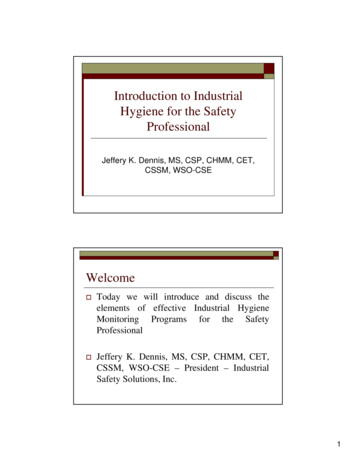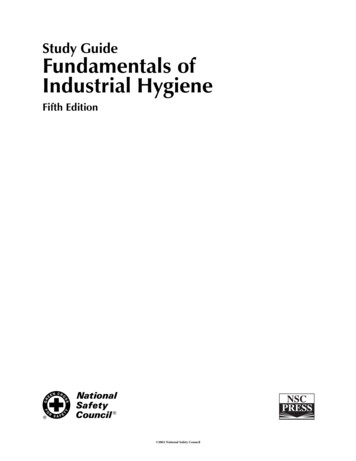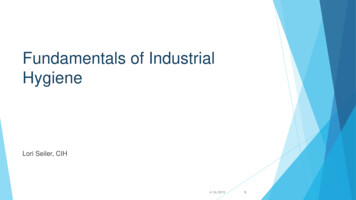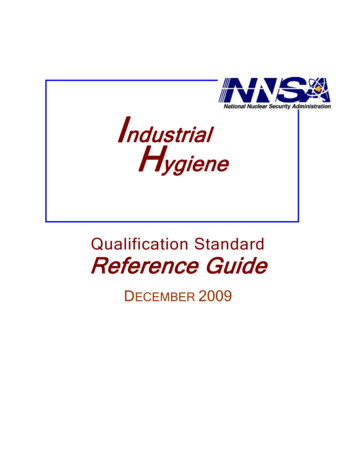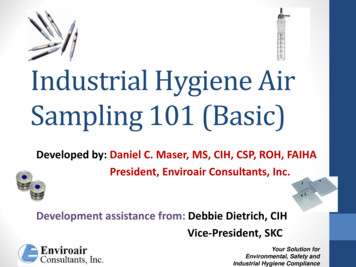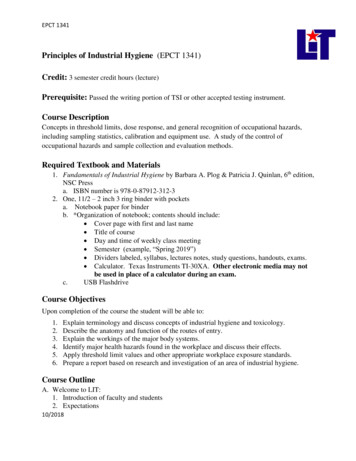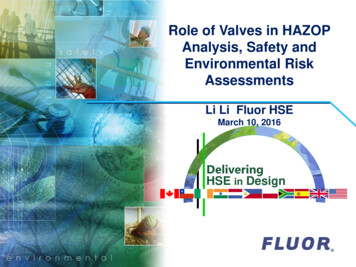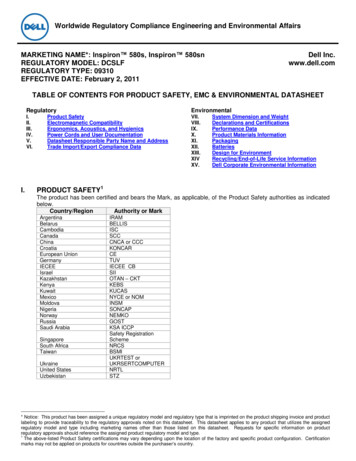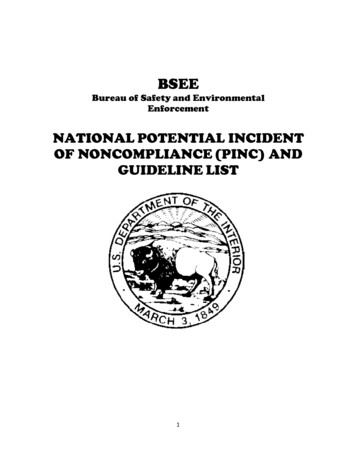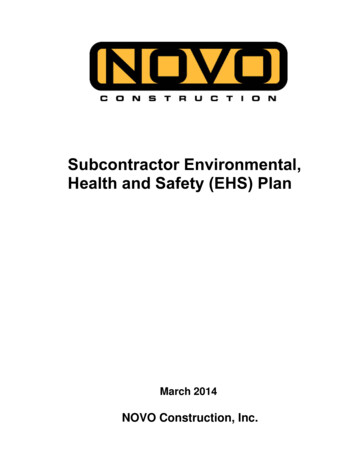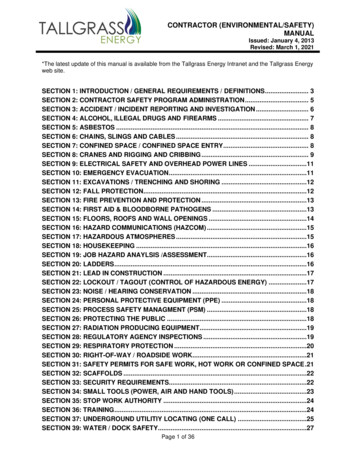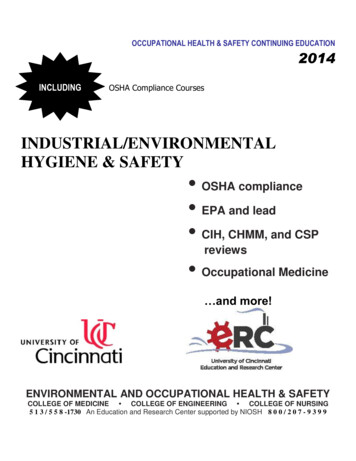
Transcription
OCCUPATIONAL HEALTH & SAFETY CONTINUING EDUCATION2014INCLUDINGOSHA Compliance CoursesINDUSTRIAL/ENVIRONMENTALHYGIENE & SAFETY OSHA compliance EPA and lead CIH, CHMM, and CSPreviews Occupational Medicine and more!ENVIRONMENTAL AND OCCUPATIONAL HEALTH & SAFETYCOLLEGE OF MEDICINE COLLEGE OF ENGINEERING COLLEGE OF NURSING5 1 3 / 5 5 8 -1730 An Education and Research Center supported by NIOSH 8 0 0 / 2 0 7 - 9 3 9 9
About CincinnatiThe livability, charm and diversity of this riverfrontcity and the pride of its 1.98 million inhabitantsmake it easy to understand why Cincinnati hasbeen called "one of the best kept secrets inAmerica." Love of the arts and a preoccupationwith the sciences took root early and continue toflourish in this busy metropolis. Cincinnati is wellknown for its many fine restaurants, and for itscultural and educational assets which rival thoseof many larger cities.Today few cities can match what Cincinnati hasto offer musically: the Cincinnati SymphonyOrchestra, the May Festival, the Cincinnati Operaand the Cincinnati Ballet Company. Cincinnatialso boasts three fine art museums and anumber of commercial galleries. The Playhousein the Park, located atop Mt. Adams, providesexcellent classical and innovative theaterperformances.Cincinnati offers recreational facilities as well.The Ohio River is a playground for boaters. Thecity and surrounding Hamilton County haveparks, woods and lakes aplenty. The CincinnatiPublic Recreation Commission has 25 municipaltennis courts and seven golf courses. There aremany private tennis and golf clubs and the city isthe venue of several professional tournaments.The pride of Cincinnati sports fans is the city'stwo major league teams, the Reds and theBengals. Other leisure-time assets are theCincinnati Zoo, a world leader in breedinganimals in captivity, and the Krohn Conservatory,which attracts visitors throughout the year to itsdisplay of exotic plants and flowers.Cincinnati is also a major center of learning. TheUniversity of Cincinnati, of which the AcademicHealth Center is a part, dates back to 1819. Oneof the earliest municipal universities in the UnitedStates, it has been a full state university since1977. It now boasts an enrollment of over 40,000undergraduate and graduate students in its day,night, part-time and other programs. Otherinstitutions of higher learning include the HebrewUnion College, the oldest Jewish theologicalschool in America and Xavier University.Register Early!https://webapps.uc.edu/CMRS/ohs-ceor see the last page for a registration form.
University of CincinnatiNIOSH Education andResearch CenterTiina Reponen, PhD, Center DirectorDirector, Targeted Research TrainingProgramKermit Davis, PhD, CPEDirector, Environmental andOccupational Hygiene Training ProgramSusan Reutman, BSN, MPH., Ph.D.Director, Occupational Health NursingTraining ProgramAmit Bhattacharya, Ph.D., CPEDirector, Continuing EducationDirector, Pilot Project Research TrainingProgramAndrew Freeman, MD,Director, Environmental andOccupational Medicine TrainingProgramJay Kim, PhD,Director, Occupational Safety andHealth Engineering Training ProgramGlenn Talaska, Ph.D., CIHDirector, Biological Monitoring ProgramTraining ProgramTable of ContentsCourse Listing . 3-4Great Lakes OSHAEducation CenterWilliam G. Menrath, DirectorCourse Directors .5 Marianne Kautz, Program ManagerCourses . 6-30 Occupational Health & SafetyOn-Site Training Information .29OSHA Public Sector Safety & Health Fundamentals CertificateProgram .29How to Register .30Registration Form .31Continuing EducationKettering Labs, Room 129BUniversity of Cincinnati, ML-00563223 Eden Ave.Cincinnati, Ohio 45267-0056800/207-9399www.eh.uc.edu/hsce
2014 Course ListingEnvironmental/Industrial Hygiene and SafetyAir Sampling for Toxic SubstancesAssociate Safety and Certified Safety Professional Comprehensive ReviewsCIH Examination Review for Industrial Hygiene ProfessionalsErgonomic Control Programs to Prevent Injuries in IndustryHazardous Materials Management Certification ReviewIndustrial Hygiene FundamentalsIntroduction to Industrial ToxicologyOffice ErgonomicsOverview of Respiratory ProtectionPilot Research Project SymposiumPrinciples of Ergonomics, 2255Quantitative Fit Test WorkshopRespirator Fit Test WorkshopRespirator Selection and Development of Cartridge Change-out WorkshopPage66687779898,19111010Occupational Health NursingFit Test Refresher and Advanced TopicsNIOSH-Approved SpirometryPrinciples & Practice of Occupational HealthNIOSH-Approved Spirometry RefresherSpirometry Fundamentals Workshop1110121111Occupational MedicineInterpretation of Spirometry: Beyond the Numbers (formerly Spirometry for Physicians)11Lead Abatement TrainingLead Inspector TrainingLead Exposure Risk AssessmentLead Abatement Training for Contractor/SupervisorLead Risk Assessor RefresherLead Supervisor RefresherClearance Technician Training131313141413Essentials for Healthy Homes Practitioners15(continued on next page)800/207-9399www.eh.uc.edu/hsceclick on “Course Catalogue”3
2014 Course Listing (cont.)OSHA TrainingBlood-borne Pathogens Exposure Control for Healthcare Facilities, OSHA 7200Collateral Duty Course for Other Federal Agencies, OSHA 6010Disaster Site Worker's Safety and Health Training, OSHA 7600Disaster Site Worker's Safety and Health Training Train-the-Trainer, OSHA 5600Electrical Standards, OSHA 3095Evacuation and Emergency Planning, OSHA 7105Excavation, Trenching and Soil Mechanics, OSHA 3010Fall Protection, OSHA 3115Fall Hazard Awareness For Construction, OSHA 7405Hazardous Materials, OSHA 2015Health Hazard Awareness, OSHA 7205Introduction to Accident Investigations, OSHA 7505Introduction To OSHA For Small Businesses, OSHA 7510Introduction to Combustible Dust Hazards, OSHA 7120Introduction to Machinery & Machine Guarding Safeguarding, OSHA 7100Introduction to Safety & Health Management, OSHA 7500Lockout/Tagout: Controlling Hazardous Energy to Prevent Workplace Industry, OSHA 7115Machinery and Machine Guarding Standards, OSHA 2045Managing Excavation Hazards, OSHA 7410Noise in Construction, OSHA 7400OSHA Construction Industry Req.:Awareness of Major Hazards & Prevention Strategies, OSHA 7415OSHA Guide to Industrial Hygiene, OSHA 521OSHA’s Training Guidelines for Patient Handling, OSHA 7000OSHA’s Introduction to the Permit Required Confined Space Standard, OSHA 7300OSHA Trainer Course for the Maritime Industry, OSHA 5400OS&H Standards for the Construction Industry, OSHA 510OS&H Standards for the General Industry, OSHA 511Permit-Required Confined Space Entry, OSHA 2264Principles of Ergonomics, OSHA 2255Public and Industrial Warehousing and Storage, OSHA 7005Recording and Reporting Occupational Injuries & Illnesses, OSHA 7845Respiratory Protection, OSHA 2225Safe Bolting: Principles & Practices, OSHA 7110Seminar on Combustible Dust Hazards, OSHA 7125Trainer Course for Construction Industry Standard, OSHA 500Trainer Course for General Industry Standard, OSHA 501Trainer Course for the Maritime Industry, OSHA 5400Update for Construction Industry Outreach Trainers, OSHA 502Update for General Industry Outreach Trainers, OSHA 503OSHA Public Sector Safety & health Fundamentals Certificate 7-9399www.eh.uc.edu/hsce4
Partial List of Course DirectorsC. Stuart Baxter, PhD, is associateprofessor in the Department ofEnvironmental Health at the University ofCincinnati Medical Center. His researchinterests lie in the responses of skin tochemical carcinogens and inflammatoryagents, and he teaches extensively onthese topics at the graduate level. He hasparticipated in continuing educationcourses for physicians and healthprofessionals for more than 30years.Mary Malotke has over 25 years ofenvironmental engineering andmanagement experience, both asenvironmental manager for Procter &Gamble and for the past 19 years aspresident of TENCON, Inc. Ms. Malotke ishighly regarded as a trainer in the fields ofenvironmental and occupational safetyand health.Amit Bhattacharya, PhD, CPE, isprofessor of Environmental Health andIndustrial Engineering at the University ofCincinnati. He has been working as aneducator, researcher, and consultant inthe area of ergonomics/ biomechanics forover 30 years. Dr. Bhattacharya is thedirector of the Biomechanics-ErgonomicsResearch Laboratory and serves on thefaculty of the Center of BiomedicalEngineering.James D. McGlothlin, MPH, PhD, CPE,retired as a research occupationalergonomist/hygienist with the EngineeringControl Technology Branch of theNational Institute for Occupational Safety& Health to enter an academic career asprofessor of Health Sciences at PurdueUniversity in 1999. Dr. McGlothlin haspioneered and received numerousnational awards for the development ofcontrol programs to preventmusculoskeletal injuries in the workplace.Jon Gans, PhD, is the Training andSafety Manager for Hytorc, the world’slargest manufacturer of precision industrialbolting tools. Jon has co-authored anumber of training programs in boltingtechnology including the OTI course:“Bolting Safety: Principles and Practices.”He is the principal instructor for thiscourse and for training and qualifyinginstructors from partner companies andschools. He earned his Doctorate atCornell University in 2000.Michael W. Hayslip, Esq., is a graduateof the University of Cincinnati's CivilEngineering program and is a licensedattorney in the state of Ohio. Mr. Haysliphas more than 16 years of hands-onconstruction safety experience through hiswork with the Jones Group, KokosingConstruction, Baker ConcreteConstruction, Wilcon Corporation andLithko Contracting, Inc.Andrew Maier, Ph.D., CIH, DABT has 20years of experience in health riskassessment and occupational toxicology.He develops and applies methods forsetting exposure limits for acute andchronic exposures and conductsintegrated risk assessments. He servesas a Toxicology Fellow with NIOSH and ispast-Chair of the WEEL Committee.Roy T. McKay, PhD, has more than 25years of experience with respiratoryprotection and pulmonary function testingat the University of Cincinnati. In additionto his faculty appointment, Dr. McKay isdirector of the Occupational Pulmonaryprogram at the Center for OccupationalHealth. Dr. McKay has taught respiratoryprotection and pulmonary function testingworldwide, including Japan, Germany,England, Australia, Belgium, Mexico,China and many other locations. Dr.McKay has numerous prestigiouscommittee appointments withresponsibility for setting standardsworldwide.James R. Nisbet , President, BenchmarkAviation Marine, Consulting; has 35 yearsexperience in maintenance andengineering, in both aviationand marine operations with humanfactors as a focus in environ-mental andOSHA safety. He has worked with theU.S. Coast Guard, American Airlines, PortAuthorities, State Maritime initiatives,City Management, FAA Focus Groupsand the Department of Labor MaritimeTraining. He is an alumnus of LakeForest Graduate School of ManagementTimothy Roberts is the Founder andPresident of Safety Alliance LLC. He isresponsible for OSHA training for his clientsand clients of the University of Cincinnati.He is an adjunct professor for the College ofApplied Science-Construction SafetyManagement at the University of Cincinnati.He is an authorized OSHA Outreach trainer,a trainer for the American Red Cross &Butler Tech College.James D. Romine, MS, CIH, CHMM,CSP, directs the Hazardous MaterialsManagement course by applying 25 years of hazardous materials managementexperience. Mr. Romine uses lessonlearned techniques from his private-,government- and academic-sectoremployment to facilitate learning regulatoryand administrative requirements. He iscertified as an HMM at the masters level,and a CIH in the comprehensive aspect.Glenn Talaska, Ph.D.,CIH has abackground in industrial hygiene, genetictoxicology, and carcinogenesis. Hisresearch is related to biological monitoring,chemical carcinogens and includes DNAadduct analysis, cytogenetics andmetabolite analysis. He is the Vice Chairof the ACGIH Biological Exposure IndicesCommittee.Larry W. Wilson, president of his ownconsulting firm, has 25 years of experiencein the fields of safety and occupationalhealth. Prior to forming his consulting firm,Mr. Wilson served as safety/securitymanager for a chemical plant and workedas an OSHA compliance officer. He hasdeveloped and taught safety and healthcourses for various companies andacademic institutions.5
Air Sampling for ToxicSubstancesBenefitsThis three-day course relies heavily on handson experiences. Trainees will be able to applytheir training on air sampling methodsimmediately upon returning to their jobs.Who Should AttendThose who have responsibility forenvironmental compliance at their facilities,including safety officers, facilities operationsstaff, plant managers, supervisors, engineers,industrial hygienists, and others.Objectives: At the end of this course thetrainees should be able to:Determine common contaminants theiremployees are exposed to and at whatlevels.Demonstrate selected methods,equipment and strategies used for airsampling.PrerequisiteFundamentals of Industrial Hygiene or anequivalent overview course of industrialhygiene fundamentals. Contact programdirector, Dr. Judy Jarrell (800.207.9399) fordetails.Partial List of Course TopicsArea Sampling vs. Personal SamplingGrab Sampling & Integrated SamplingLaboratory SelectionSampling Equipment MethodsHands-on Workshops include: samplingpump calibration, combustible gas andoxygen meters, Niton X-RayFluorescence Meter, personal &clearance sampling for asbestos, pumpmaintenance and repair, hydrogen sulfideand carbon monoxide meters, statisticalapproaches to sampling, asbestosregulations and monitoring.Course Director:James D. Romine, MS, CIH, CHMM, CSPCourse Dates:Class Size:September 23-26, 201412 maximumTuition: 595Credit:2. CEUsAssociate SafetyProfessional and CertifiedSafety ProfessionalComprehensive Reviews*BenefitsParticipants will receive a fast-paced review ofthe major topics covered in the ASP and CSP(Comprehensive Practice) examinationsadministered by the Board of Certified SafetyProfessionals. Question and answer formathelps to prepare participants for types ofproblems encountered in the certificationexam.Who Should AttendIn addition to those professionals who arepreparing for the certification exams given bythe BCSP, this course will be valuable forindustrial hygienists whose work assignmentshave expanded to include occupational safety.Persons intending to take the ASP or CSPexams are advised to contact the BCSP at217/359-9263 for application materialsapproximately 6-8 months prior to theexam.Partial List of Course TopicsApplied EngineeringReview of MathematicsHuman PhysiologyDimensional AnalysisReview of ChemistryStatistics and ProbabilitySystem SafetyHuman FactorsSafety ManagementBiohazardsMechanical HazardsRadiationIlluminationEngineering EconomyTraining TechniquesCourse Director: James D. Romine, MS,CIH, CHMM, CSPCIH Examination Review forIndustrial HygieneProfessionalsBenefitsThis course is a review of the entire field ofindustrial hygiene in preparation for the ABIHcertification examination. Emphasis is placed onthe evaluation and control of occupational safetyand health hazards. Key features of the programare the twice-daily quizzes which are used toevaluate preparedness to take the ABIH exam.We recommend the course be taken severalmonths in advance of the exam."Wonderfully prepared and greatlyhelpful in my efforts to both pass theCIH exam and to continueimprovement on my professionalresponsibilities. Having experts intheir respective topics lecturing wasa pleasure.”Participant – 8/2010Who Should AttendThis course is designed specifically for thoseindividuals who are preparing for the ABIHcertification examination.Partial List of Course Topics Standards, Regulations, Guidelines Sampling of Dusts, Fumes, Mists, Gases andVapors Analytical Techniques for IH Samples Radiation, Ionizing and Non-Ionizing Ventilation/Engineering Control Toxicology Noise and Vibration Air Pollution Heat Stress Ergonomics Personal Protective Equipment Problem Solving in All IH Areas Management How to Study for Maximum RetentionCourse Dates:July 8-11, 2014Course Director: Glenn Talaska, PhD, CIHCourse Dates:February 24-28, 2014August, 18-22, 2014Class Size:12 maximumClass Size:Tuition: 725 eachTuition: 1200Credit Awarded: 4 CEUsDiscounts: DEH Student Alumni 25%NIOSH and Other FederalAgencies 50%UC Alumni 10%Credit Awarded: 2.8CEUs*These4-day courses run concurrently onthe dates listed above.12 maximum. Jarrell presents "How to6
Hazardous MaterialsManagement CertificationReviewBenefitsHazardous Materials ManagementCertification is an important credential forhazardous materials managers/engineers. Thisprogram will provide the hazardous materialsprofessional with a review of the regulatoryand administrative requirements as well astechnical areas in preparation for theCertification Examination. The exam isoffered by the Hazardous MaterialsManagement. Please contact them to makearrangements to take exam.Who Should AttendPersons with responsibilities in hazardousmaterials management/engineering, who wishto pursue professional certification.Exam Application InformationApplications for examination must be obtainedfrom the Institute of Hazardous MaterialsManagement, 11900 Parklawn Drive, Ste. 450,Rockville, MD 20852, 301/984-8969.Application must be made at least six weeksprior to the examination. Registration for theReview Course should be made directly withthe University of Cincinnati, using theregistration form in this catalogue.Partial List of Course TopicsLaws and RegulationsGenerator and TransporterRequirementsEmergency ResponseManagement of Hazardous MaterialsProgramsToxicology and Chemical SafetyIndustrial HygieneTreatment and DisposalAir PollutionUnderground Storage TanksPolychlorinated BiphenylsSuperfundProperty AssessmentsIntroduction to IndustrialToxicologyBenefitsModern basic concepts of toxicology will bepresented with emphasis on the assessment ofoccupational risk from data derived from bothepidemiologic and basic research studies.Strategies for monitoring exposure to workersalso will be discussed. Special emphasis willbe on currently prominent issues such asfactors controlling prominent issues such asfactors controlling individual susceptibility,assessment of mutation and cancer risk,modern bio-monitoring methods, andextrapolation of data from animal to man. Thepresentations will use a practical, easy-tounderstand approach. A manual will beprovided to minimize note taking and will alsoserve as a valuable source of referencematerial.Who Should AttendThis course is designed for individuals whorequire a basic, comprehensive, up-to-datereview and understanding of toxicology in theoccupational setting. The information shouldbe of considerable value to all those interestedin occupational health and safety, includingindustrial hygienists, safety professionals, andnurses, and physicians.Objectives To present modern concepts in toxicologywith special emphasis on the workplaceenvironment. To review current bio-monitoring techniquesand test methods for carcinogenicity andmutagenicity which are appropriate for use inindustry To describe available strategies for makingrisk assessments in the industrial setting.Partial List of Topics: Factors Controlling Individual Risk to ToxicAgents Carcinogenesis and Mutagenesis TestingMethods Current Bio-monitoring Techniques Biometrics Pharmacokinetics and Risk Assessment Toxic Responses of Selected IndividualTissuesCourse Director: James D. Romine, MS,CIH, CHMM, CSPCourse Director: Michael Maier, Ph.D., CIHCourse Dates:July 1-3, 2014Course Dates:Class Size:12 maximumClass Size:12 maximumTuition: 750Tuition: 595(exam fee additional- pay to Institute)Industrial HygieneFundamentalsBenefitsFundamentals of basic techniques involved in therecognition, evaluation, and control of potentialhealth hazards in the workplace. This course isfor those with minimal previous training inindustrial hygiene. Use of material safety datasheets, Threshold Limit Value lists,NIOSH/OSHA publications and other sources todetect potential health hazards are described.Relevant Federal, state, and local legislation isreviewed. Methods of evaluation for thepresence of physical hazards (noise, heat,radiation) and chemical hazards (dusts, fumes,gases, vapors) are covered. Industrial hygieneexposure situations will be covered. Samplingequipment use, direct-reading instruments,general principles of noise control, ventilationsystem design/evaluation, general toxicology andergonomics will be included.Who Should AttendThis course is designed for safety personnel, andpersons newly assigned to industrial hygieneresponsibility in a company or firm.Learning Objectives Recognize potential workplace healthhazards;Discuss the evaluation of potentialworkplace health hazards;. Recognize the proper use of instrumentswhich measure these hazards Describe the operations of control systems.Partial List of Topics:Government RegulationsGeneral ToxicologyErgonomics and Heat StressMeasurement of Dusts, Fumes, Fibers,Gases, VaporsCalibration and Use of Air SamplingInstrumentsNoise and Radiation MeasurementVentilation Measurement and DesignUseful References in Industrial HygieneAdministration and Work Practice ControlsPersonal Protective Equipment, includingRespiratorsSeptember 23-26, 2014Credit Awarded: 2.4 CEUsCredit Awarded: 1.8 CEUsBack by Popular Demand!Course Director: Glenn Talaska, PhD, CIHCourse Dates:April 15-18, 2014December 16-19, 2014Class Size:12 maximumTuition: 1000Credit Awarded: 2.4 CEUs7
ErgonomicsCoursesPrinciples of Ergonomics,OSHA #2255 (formerlyOffice Ergonomics"Occupational Ergonomics")Course Objectives:*Partial List of Course TopicsManual Materials Handling/NIOSH WorkPracticesJob AnalysisErgonomic Aspects of VDT StationsWorkplace/Tool DesignCarpal Tunnel Syndrome and Other CTDsAnthropometry and BiomechanicsVibration White Finger DiseasePredictive Computer ModelsErgonomic Case StudiesRehabilitation of the Worker with ChronicDisabilityFunctional Capacity Evaluation RelevanttoJob DemandsDeveloping and Managing an ErgonomicsProgramPractical Risk Assessment and MethodsOSHA's Ergonomics ProgramHeat StressIndustrial LightingLaboratoriesSafe Lifting Technique and LiftingStrength TestingEvaluation of the VDT WorkstationUse of Videography and an ErgonomicChecklist to Identify Upper ExtremityTraumaComputer Models for Ergonomic ProblemSolvingHeat Stress MeasurementCourse Director: Amit Bhattacharya, PhD,CPECourse Dates:July 21-23, 2014Tuition: 675Trainees will gain an understanding of theprinciples and techniques for applyingstate-of-the-science ergonomic controls tooffice musculoskeletal disorders. Traineeswill learn the seven steps of an ergonomicsprogram approach to identify, analyze,solve, and prevent problems associatedwith office work environments. Finally,trainees will get hands-on training in howto recognize, evaluate, and modify realworld office work stations to reduce andprevent musculoskeletal disorders.Partial List of Course Topics:Identifying the most common officerelated musculoskeletal disordersSolving musculoskeletal disorders byusing office ergonomics guidelinesSymptomsSurvey checklistsNIOSH lifting evaluation2-D and 3-D analysis of workpostures and stressorsWorkstation organization and design.FIELD EVALUATION &APPLICATIONS!!CourseDirector:James D. McGlothlin,PhD, CPECourse Dates:Tuition:July 24-25, 2014 395CreditAwarded:1.4 CEUs;Credit Awarded: 2.1 CEUs1.9 OSHA CEUs.8
Annual Pilot Research Project SymposiumThis symposium disseminates the results of the pilot research projects and shows the diverse research interestsamong investigators, faculty and students in occupational health and safety areas. It is intended to foster thedevelopment of additional collaborative efforts and to illustrate the many opportunities for pursuingoccupational health and safety research.Course Director:Amit Bhattacharya, PhD, CPECourse Date:October, 9-10, 2014Tuition:None – registration, however, is requiredCredit Awarded:.6 CEUNo Charge!!Nursing hours will be approved for 2014.9
Respiratory and Spirometry Courses: Call Dr. Roy T. McKay: 513/558-1234 to register!Overview of RespiratoryProtectionThis course provides a practical overview ofrespirators and respirator programrequirements, and is designed primarily forstudents with little/no prior formal training.Although supplied air and self-contained(SCBA) respirators will be discussed, theemphasis of this course will be on air-purifyinghalf- and full-face respirators.Partial List of Course Topicsuse, selection and care of respiratorsrespirator program requirementsregulations (OSHA, NIOSH, ANSI)filters and cartridge for APRsproblem solving, common pitfallsrequirements for medical clearancefit test requirementsCourse Director: Roy T. McKay, PhDCourse Dates:April 8, 2014October 28, 2014Tuition: 270 *Credit Awarded: .7 CEUs*Take this course with "Respirator Fit TestingWorkshop" for a total of 560.NIOSH-Approved SpirometryThis NIOSH-approved spirometry trainingcourse (approval #010) deals with all aspects ofspirometry testing, and uses a combination oflectures and hands-on practice. At the end ofthis 3-day course the participant will be able touse the proper technique to obtain test resultsmeeting American Thoracic Society (ATS)requirements. The students will be able tocalculate specific test results and to understandtheir meaning.Partial List of Course TopicsRationale for Spirometry Testing in theWorkplaceMeasurement and Calculation of FVC,FEV1, FEV1/FEC ratioTechnique for Performing SpirometryHands-on Spirometry TestingInterpretation of Test ResultsInstruments Standards andRequirementsCourse Director: Roy T. McKay, Ph.D.Course Dates:April 1-3, 2014May 13-15, 2014June 24-26, 2014September 9-11, 2014December 9-11, 2014Tuition: 645Credit Awarded: 2.3 CEUsFit Testing WorkshopThis two-day workshop provides detailedinformation and "hands-on" experience forconducting qualitative and quantitativerespirator fit testing. At the end of this two-dayworkshop the student will be able to conductrespirator fit testing including qualitative andquantitative methods to satisfy regulatoryrequirements.Partial List of Course TopicsHow to inspect respirators prior to fittesting.Mask donning, fitting tips, user sealchecksSaccharin Sweetener and BitrexQualitative fit test procedures anddemonstrationsQuantitative fit testing with the TSIPortaCount & Fit Tester 3000Interpretation of OHD QuantifitCourse Director: Roy T. McKay, PhDCourse Dates:October 29-30, 2014Tuition: 570*Credit Awarded: 1.4 CEUs*Take this course with "Overview ofRespiratory Protection" for 690.Spirometry Refresher (NIOSHapproved)This one-day NIOSH-approved refreshercourse will review recent changes in spirometrystandards and guidelines published by theAmerican Thoracic Society (ATS) andEuropean Respiratory Society (ERS). As ofJanuary 2009, technicians must now completean approved Refresher course every 5 years tokeep their NIOSH-Approved Spirometrycourse certificate active. This program willalso provide additional insight towards theunderstanding, significance, and interpretationof lung function tests. Students will also gain abetter understanding of sub-maximal effort,invalid maneuvers, and other factors that affectinterpretation of the test. Examples of poorlyconducted tests will be used to provide insighttowards improving coaching technique.Course Dates: April 23, 2014September 16, 2014Tuition: 320Credit Awarded: .7 CEUs7 Nursing Contact hoursTo Register for Dr. McKay’s courses goto: www.DrMcKay.com23.1 Nursing Contact hoursRespirator Selection andDevelopment of CartridgeChange Out SchedulesThis 2-day workshop will provide guidance onrespirator selection and the development ofOSHA-compliant change-out schedules forcartridges and filters. At the end of this 2-dayworkshop the student will be able to select arespirator based on workplace conditions(exposure level, type of contaminant, etc.).This comprehensive course will train studentson twelve different methods for determinationof cartridge change out schedules, includingthree methods for handling mixtures.Partial List of Course TopicsOSHA guidelines for respiratorselectionRespirator selection tricks of the tradeFilter selection issues.Calculating MUC's for mixturesPractical problems and solutionsModels for change out schedulesCourse Director:Course Date:Tuition:Credit Awarded:Roy T. Mckay, Ph.D.March 26-27,2014 4601.1 CEUS10
Fit Test Workshop:QuantitativeAt the end of this one-day workshop t he studentwill be able to fit test a variety of different stylerespirators including filtering face-pieces,elastomeric half and full face-piece respirators asrecommended by OSHA with TSI PortaCount, TSIPortaCount with N-95 Companion, and the OHD FitTester 3000. Students will learn how to set-up,operate, maintain, troubleshoot, analyze, andinterpret fit test results. This course is only forquantitative fit testing methodsCourse Director: Roy T. Mckay, Ph.D.Course Date:April 9, 2014Tuition: 250/400*Spirometry Fundamentals WorkshopThis course is designed for person working in family practice, internal medicine andother clinical basic fundament
OSHA Guide to Industrial Hygiene, OSHA 521 18 OSHA’s Training Guidelines for Patient Handling, OSHA 7000 27 OSHA’s Introduction to the Permit Required Confined Space Standard, OSHA 7300 27 OSHA T
